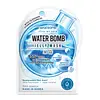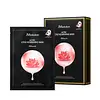What's inside
What's inside
 Key Ingredients
Key Ingredients

 Benefits
Benefits

 Concerns
Concerns

 Ingredients Side-by-side
Ingredients Side-by-side

Water
Skin ConditioningPanthenol
Skin ConditioningMethylpropanediol
SolventButylene Glycol
HumectantGlycerin
Humectant1,2-Hexanediol
Skin ConditioningHydroxyacetophenone
AntioxidantTrehalose
HumectantAcrylates/C10-30 Alkyl Acrylate Crosspolymer
Emulsion StabilisingArginine
MaskingAllantoin
Skin ConditioningXanthan Gum
EmulsifyingDipotassium Glycyrrhizate
HumectantDisodium EDTA
Propanediol
SolventCitrus Limon Fruit Extract
MaskingMalpighia Glabra Fruit Extract
Skin ConditioningMyrciaria Dubia Fruit Extract
Skin ConditioningSodium Hyaluronate
HumectantHydrolyzed Glycosaminoglycans
HumectantCentella Asiatica Extract
CleansingBifida Ferment Lysate
Skin ConditioningLactose
HumectantSodium Hyaluronate Crosspolymer
HumectantHydrolyzed Hyaluronic Acid
HumectantAscorbyl Glucoside
AntioxidantHydroxypropyltrimonium Hyaluronate
Madecassoside
AntioxidantHyaluronic Acid
HumectantSodium Acetylated Hyaluronate
HumectantWater, Panthenol, Methylpropanediol, Butylene Glycol, Glycerin, 1,2-Hexanediol, Hydroxyacetophenone, Trehalose, Acrylates/C10-30 Alkyl Acrylate Crosspolymer, Arginine, Allantoin, Xanthan Gum, Dipotassium Glycyrrhizate, Disodium EDTA, Propanediol, Citrus Limon Fruit Extract, Malpighia Glabra Fruit Extract, Myrciaria Dubia Fruit Extract, Sodium Hyaluronate, Hydrolyzed Glycosaminoglycans, Centella Asiatica Extract, Bifida Ferment Lysate, Lactose, Sodium Hyaluronate Crosspolymer, Hydrolyzed Hyaluronic Acid, Ascorbyl Glucoside, Hydroxypropyltrimonium Hyaluronate, Madecassoside, Hyaluronic Acid, Sodium Acetylated Hyaluronate
Water
Skin ConditioningGlycerin
HumectantMethylpropanediol
SolventCaprylic/Capric Triglyceride
MaskingEthylhexyl Palmitate
EmollientDipropylene Glycol
HumectantC14-22 Alcohols
Emulsion StabilisingSorbitan Sesquioleate
EmulsifyingDimethicone
EmollientHydroxyacetophenone
AntioxidantCetyl Alcohol
EmollientCaprylyl Glycol
EmollientTrehalose
HumectantAcrylates/C10-30 Alkyl Acrylate Crosspolymer
Emulsion StabilisingTriethylamine
Emulsion StabilisingC12-20 Alkyl Glucoside
EmulsifyingAllantoin
Skin ConditioningStearyl Alcohol
EmollientXanthan Gum
EmulsifyingDipotassium Glycyrrhizate
HumectantHelianthus Annuus Seed Oil
EmollientButylene Glycol
HumectantXylitylglucoside
HumectantDisodium EDTA
Myristyl Alcohol
EmollientAnhydroxylitol
Humectant1,2-Hexanediol
Skin ConditioningXylitol
HumectantNelumbium Speciosum Flower Extract
Skin ConditioningNelumbium Speciosum Flower Water
TonicGlyceryl Acrylate/Acrylic Acid Copolymer
HumectantSodium Hyaluronate
HumectantPvm/Ma Copolymer
Emulsion StabilisingGlyceryl Glucoside
HumectantHibiscus Sabdariffa Flower Extract
Skin ConditioningRosa Canina Flower Extract
AstringentFicus Carica Fruit Extract
HumectantPunica Granatum Fruit Extract
AntioxidantSea Water
HumectantPanthenol
Skin ConditioningCI 16185
Cosmetic ColorantUlmus Campestris Bark Extract
AstringentGlycine Max Seed Extract
Skin ConditioningArtemisia Princeps Leaf Extract
Skin ConditioningCalendula Officinalis Extract
Skin ConditioningCI 15985
Cosmetic ColorantAstaxanthin
Skin ConditioningBacillus Ferment
Skin ConditioningLactobacillus Ferment
Skin ConditioningAspergillus Ferment
Skin ConditioningPalmitoyl Tripeptide-5
Skin ConditioningThiamine Hcl
MaskingPyridoxine
Skin ConditioningHyaluronic Acid
HumectantHydrolyzed Hyaluronic Acid
HumectantBiotin
AntiseborrhoeicCyanocobalamin
Skin ConditioningRiboflavin
Cosmetic ColorantFolic Acid
Skin ConditioningMenadione
MaskingBioflavonoids
Skin ConditioningAscorbic Acid
AntioxidantTocopheryl Acetate
AntioxidantGlutathione
Water, Glycerin, Methylpropanediol, Caprylic/Capric Triglyceride, Ethylhexyl Palmitate, Dipropylene Glycol, C14-22 Alcohols, Sorbitan Sesquioleate, Dimethicone, Hydroxyacetophenone, Cetyl Alcohol, Caprylyl Glycol, Trehalose, Acrylates/C10-30 Alkyl Acrylate Crosspolymer, Triethylamine, C12-20 Alkyl Glucoside, Allantoin, Stearyl Alcohol, Xanthan Gum, Dipotassium Glycyrrhizate, Helianthus Annuus Seed Oil, Butylene Glycol, Xylitylglucoside, Disodium EDTA, Myristyl Alcohol, Anhydroxylitol, 1,2-Hexanediol, Xylitol, Nelumbium Speciosum Flower Extract, Nelumbium Speciosum Flower Water, Glyceryl Acrylate/Acrylic Acid Copolymer, Sodium Hyaluronate, Pvm/Ma Copolymer, Glyceryl Glucoside, Hibiscus Sabdariffa Flower Extract, Rosa Canina Flower Extract, Ficus Carica Fruit Extract, Punica Granatum Fruit Extract, Sea Water, Panthenol, CI 16185, Ulmus Campestris Bark Extract, Glycine Max Seed Extract, Artemisia Princeps Leaf Extract, Calendula Officinalis Extract, CI 15985, Astaxanthin, Bacillus Ferment, Lactobacillus Ferment, Aspergillus Ferment, Palmitoyl Tripeptide-5, Thiamine Hcl, Pyridoxine, Hyaluronic Acid, Hydrolyzed Hyaluronic Acid, Biotin, Cyanocobalamin, Riboflavin, Folic Acid, Menadione, Bioflavonoids, Ascorbic Acid, Tocopheryl Acetate, Glutathione
Ingredients Explained
These ingredients are found in both products.
Ingredients higher up in an ingredient list are typically present in a larger amount.
1,2-Hexanediol is a synthetic liquid and another multi-functional powerhouse.
It is a:
- Humectant, drawing moisture into the skin
- Emollient, helping to soften skin
- Solvent, dispersing and stabilizing formulas
- Preservative booster, enhancing the antimicrobial activity of other preservatives
Acrylates/C10-30 Alkyl Acrylate Crosspolymer is a synthetic polymer. It is used to thicken and improve the texture of products. Due to its properties, it can prevent water and oil ingredients from separating.
Allantoin is a soothing ingredient known for its protective and moisturizingg properties. Because of this, it is often added to products with strong active ingredients.
Studies show higher concentrations of this ingredient can promote wound healing.
Though it can be derived from the comfrey plant, allantoin is produced synthetically for cosmetic products to ensure purity.
Learn more about AllantoinButylene Glycol (or BG) is used within cosmetic products for a few different reasons:
Overall, Butylene Glycol is a safe and well-rounded ingredient that works well with other ingredients.
Though this ingredient works well with most skin types, some people with sensitive skin may experience a reaction such as allergic rashes, closed comedones, or itchiness.
Learn more about Butylene GlycolDipotassium Glycyrrhizate comes from licorice root.
Extracts of licorice have demonstrated to have antibacterial, anti‐inflammatory, antiviral, antioxidant properties.
One component, glabridin, has extra potent antioxidant and soothing properties. It has also been found to block pigmentation from UVB rays in guinea pigs.
Licorice Root also contains a flavonoid. Flavonoids are a natural substance from in plants. Flavonoids also have antioxidant properties.
Another component, glycyrrhizin, has been found to have anti-inflammatory and antimicrobial benefits. This may make licorice root extract effective at treating acne. However, more research is needed to support this.
Liquiritin is one of the flavone compounds found in licorice. It has been found to help lighten skin by preventing tyrosinase from reacting with tyrosine. When the two react, protein is converted to melanin. Melanin is the substance in your body that gives your features pigmentation.
Licorice root is native to Southern Europe and Asia. It has been used in traditional Chinese medicine to help with respiratory issues.
Learn more about Dipotassium GlycyrrhizateDisodium EDTA plays a role in making products more stable by aiding other preservatives.
It is a chelating agent, meaning it neutralizes metal ions that may be found in a product.
Disodium EDTA is a salt of edetic acid and is found to be safe in cosmetic ingredients.
Learn more about Disodium EDTAGlycerin is already naturally found in your skin. It helps moisturize and protect your skin.
A study from 2016 found glycerin to be more effective as a humectant than AHAs and hyaluronic acid.
As a humectant, it helps the skin stay hydrated by pulling moisture to your skin. The low molecular weight of glycerin allows it to pull moisture into the deeper layers of your skin.
Hydrated skin improves your skin barrier; Your skin barrier helps protect against irritants and bacteria.
Glycerin has also been found to have antimicrobial and antiviral properties. Due to these properties, glycerin is often used in wound and burn treatments.
In cosmetics, glycerin is usually derived from plants such as soybean or palm. However, it can also be sourced from animals, such as tallow or animal fat.
This ingredient is organic, colorless, odorless, and non-toxic.
Glycerin is the name for this ingredient in American English. British English uses Glycerol/Glycerine.
Learn more about GlycerinHyaluronic acid is naturally found in healthy skin. It is a humectant, meaning it draws moisture to your skin.
This ingredient helps hydrate, soothe, and protect the skin.
What makes hyaluronic acid so hydrating? It has the capacity to bind or hold large amounts of water.
Fun fact: It is already naturally found in our bodies, such as the fluids of our eyes and our joints.
Studies find this ingredient to have anti-inflammatory and anti-microbial properties. This can help speed up wound-healing.
Hyaluronic acid can be irritating if the molecule has a low-molecular weight, or if the molecules are small.
One study found low-molecular weight hyaluronic acid to be pro-inflammatory, meaning some people may experience irritation. This is because our bodies use hyaluronic acid in the wound-healing process to signal to our bodies, via irritation, that something needs healing.
The same study found high-molecular weight hyaluronic acid to be anti-inflammatory.
These are some other common types of Hyaluronic Acid:
Learn more about Hyaluronic AcidHydrolyzed Hyaluronic Acid is a form of hyaluronic acid. It is created by the hydrolysis of hyaluronic acid with a high molecular weight. Once created, Hydrolyzed Hyaluronic Acid has a low molecular weight.
Low molecular weight HA has been shown to hydrate and increase elasticity of the skin. Increasing elasticity is also associated with reduction of wrinkle depth.
One study found topical low molecular weight hyaluronic acid may be considered for the treatment of rosacea in the adult population. However, we always recommend speaking with a professional about your skin concerns.
Hyaluronic acids are a humectant. This means they draw moisture from the air. Hyaluronic acids help moisturize, soothe, and protect the skin.
Read more about other common forms of hyaluronic acid:
Learn more about Hydrolyzed Hyaluronic AcidHydroxyacetophenone is antioxidant with skin conditioning and soothing properties. It also boosts the efficiency of preservatives.
This ingredient is not irritating or sensitizing.
Methylpropanediol is a synthetic solvent and humectant.
As a solvent, it helps dissolve other ingredients, helping to evenly distribute ingredients throughout the product. This ingredient has also been shown to have antimicrobial properties which makes it a preservative booster.
Methylpropanediol is able to add a bit of moisture to the skin. It also helps other ingredients be better absorbed into the skin, such as salicylic acid.
Learn more about MethylpropanediolPanthenol is a common ingredient that helps hydrate and soothe the skin. It is found naturally in our skin and hair.
There are two forms of panthenol: D and L.
D-panthenol is also known as dexpanthenol. Most cosmetics use dexpanthenol or a mixture of D and L-panthenol.
Panthenol is famous due to its ability to go deeper into the skin's layers. Using this ingredient has numerous pros (and no cons):
Like hyaluronic acid, panthenol is a humectant. Humectants are able to bind and hold large amounts of water to keep skin hydrated.
This ingredient works well for wound healing. It works by increasing tissue in the wound and helps close open wounds.
Once oxidized, panthenol converts to pantothenic acid. Panthothenic acid is found in all living cells.
This ingredient is also referred to as pro-vitamin B5.
Learn more about PanthenolSodium Hyaluronate is hyaluronic acid's salt form. It is commonly derived from the sodium salt of hyaluronic acid.
Like hyaluronic acid, it is great at holding water and acts as a humectant. This makes it a great skin hydrating ingredient.
Sodium Hyaluronate is naturally occurring in our bodies and is mostly found in eye fluid and joints.
These are some other common types of Hyaluronic Acid:
Learn more about Sodium HyaluronateTrehalose is a disaccharide made of two glucose molecules (glucose is sugar!). Trehalose is used to help moisturize skin. It also has antioxidant properties.
As a humectant, trehalose helps draw moisture from the air to your skin. This helps keep your skin hydrated.
Due to its antioxidant properties, trehalose may help with signs of aging. Antioxidants help fight free-radical molecules, unstable molecules that may damage your skin.
In medicine, trehalose and hyaluronic acid are used to help treat dry eyes.
Some animals, plants, and bacteria create trehalose as a source of energy to survive freeze or lack of water.
Learn more about TrehaloseWater. It's the most common cosmetic ingredient of all. You'll usually see it at the top of ingredient lists, meaning that it makes up the largest part of the product.
So why is it so popular? Water most often acts as a solvent - this means that it helps dissolve other ingredients into the formulation.
You'll also recognize water as that liquid we all need to stay alive. If you see this, drink a glass of water. Stay hydrated!
Learn more about WaterXanthan gum is used as a stabilizer and thickener within cosmetic products. It helps give products a sticky, thick feeling - preventing them from being too runny.
On the technical side of things, xanthan gum is a polysaccharide - a combination consisting of multiple sugar molecules bonded together.
Xanthan gum is a pretty common and great ingredient. It is a natural, non-toxic, non-irritating ingredient that is also commonly used in food products.
Learn more about Xanthan Gum